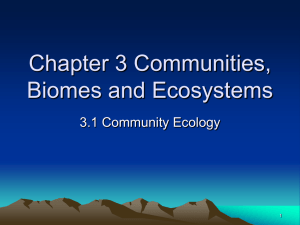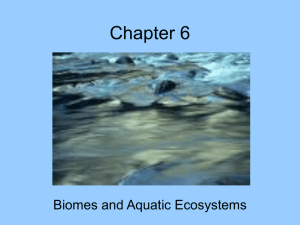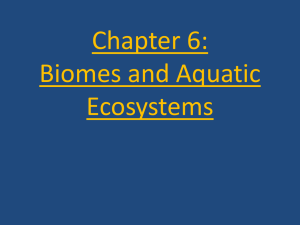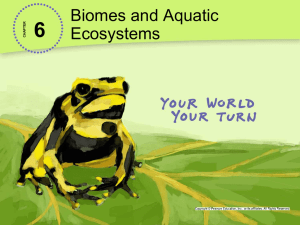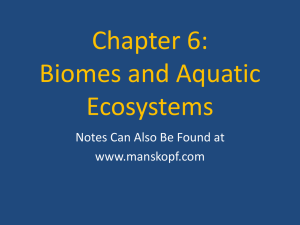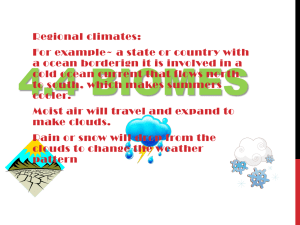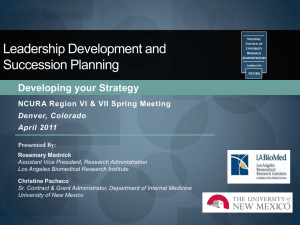Chapter 3: Communities, Biomes, and Ecosystems
advertisement
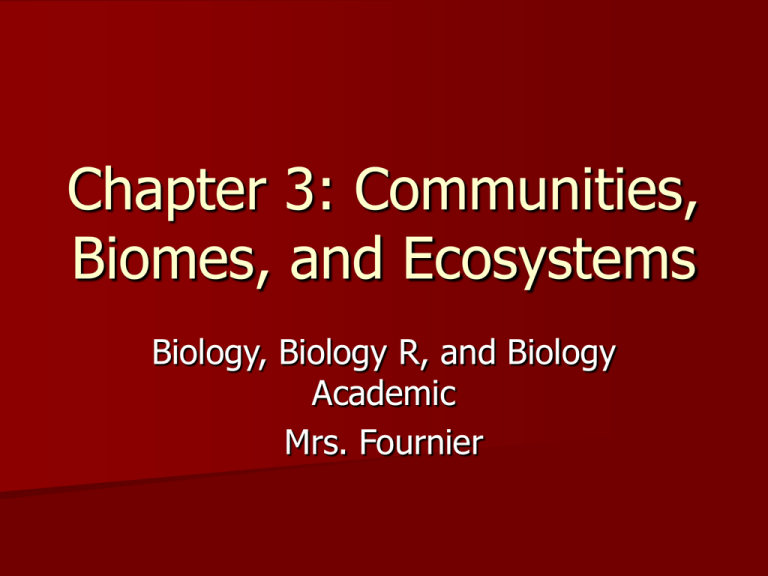
Chapter 3: Communities, Biomes, and Ecosystems Biology, Biology R, and Biology Academic Mrs. Fournier 3.1 Community Ecology Main idea - All living organisms are limited by factors in the environment. Objectives – Recognize how unfavorable abiotic and biotic factors affect a species. – Describe how ranges of tolerance affect the distribution of organisms. – Sequence the stages of primary and secondary succession. Review Vocabulary – Abiotic factor: the nonliving part of an organism’s environment Communities A biological community is a group of interacting populations that occupy the same area at the same time Limiting Factors Any abiotic or biotic factor that restricts the numbers, reproduction, or distribution of organisms is called a limiting factor. Includes sunlight, climate, temperature, water, nutrients, fire, soil chemistry, and space, and other living things. Range of Tolerance An upper limit and lower limit that define the conditions in which an organism can survive The ability of any organism to survive when subjected to abiotic factors or biotic factors is called tolerance. Ecological Succession The change in an ecosystem that happens when one community replaces another as a result of changing abiotic and biotic factors is ecological succession. There are two types of ecological succession – primary succession and secondary succession. Primary Succession The establishment of a community in an area of exposed rock that does not have any topsoil is primary succession. Pioneer Stages Primary succession usually occurs slowly at first: – Usually lichens, a combination of a fungus and algae, begin to grow on the rock. – Because lichens are among the first organisms to appear they are called pioneer species. – Pioneer species help to create soil by secreting acids that help to break down rocks. Primary Succession Then … – As the pioneer organisms die, their decaying organic materials, along with bits of sediment from the rocks, make up the first stage of soil development. – At this point, small weedy plants, including ferns and other organisms such as fungi and insects, become established. – As these organisms die, additional soil is created. Intermediate Stages Then … – Seeds, brought in by animals, water, or wind, begin to grow in the newly formed soil. – Eventually, enough soil is present so that shrubs and trees can grow. Mature Community A climax community eventually can develop from the bare rock, lichens, small annual plants, perennial herbs and grasses in the pioneer stages to the grasses, shrubs and shade-intolerant trees in the intermediate stages to the shade tolerant trees of the mature community. The stable, mature community that results when there is little change in the number of species is a climax community. Secondary Succession Secondary Succession often occurs as a result of a natural disturbance, such as, fire, flood, or a windstorm. After a disturbance, new species of plants and animals might occupy the habitat. Over time, there is a natural tendency for the species belonging to the mature community to return. The orderly and predictable change that takes place after a community of organisms has been removed but the soil has remained intact is secondary succession. Secondary Succession Pioneer species – mainly plants that begin to grow in the disturbed area – are the first species to start secondary succession. 3.2 Terrestrial Biomes Main idea – Ecosystems on land are grouped into biomes primarily based on the plant communities within them. Objectives – – Relate latitude and the three major climate zones. – Describe the major abiotic factors that determine the location of a terrestrial biome. – Distinguish among terrestrial biomes based on climate and biotic factors. Review Vocabulary – Biome: a large group of ecosystems that share the same climate and have similar types of plant communities. Effects of Latitude and Climate Weather is the condition of the atmosphere at a specific place and time. One of the keys to understanding these communities is to be aware of latitude and climatic conditions. Effects of Latitude and Climate The distance of any point on the surface of Earth north or south from the equator is latitude. Latitude range from 0˚ at the equator to 90˚ at the poles. Earth’s surface is heated differently in different areas. Ecologists refer to these areas as polar, temperate, and tropical zones. Effects of Latitude and Climate The average weather conditions in an area, including temperature and precipitation, describe the area’s climate. The graph shows how temperature and precipitation influence the communities. Biomes are classified primarily according to the characteristics of their plants. Major Biomes are also characterized by temperature, precipitation, and animal species. Tundra A treeless biome with a layer of permanently frozen soil below the surface called permafrost. Average precipitation: 15–25 cm per year Temperature range: -34°C–12°C Geographic location: South of the polar ice caps in the Northern Hemisphere Abiotic factors: soggy summers; permafrost; cold and dark much of the year Boreal Forest South of the tundra is a broad band of dense evergreen forest also called the northern coniferous forest, or taiga. Average precipitation: 30–84 cm per year Temperature range: -54°C–21°C Geographic location: northern part of North America, Europe and Asia. Abiotic factors: summers are short and moist; winters are long, cold, and dry Temperate Forest Is composed mostly of broad-leaved deciduous trees – shed their leaves in autumn. Average precipitation: 75–150 cm per year Temperature range: -30°C–30°C Geographic location: south of the boreal forests in eastern North America, eastern Asia, Australia, and Europe Abiotic factors: well-defined seasons; summers are hot, winters are cold Temperate Woodland and Shrubland Open woodlands and mixed shrub communities are found in areas with less annual rainfall than in temperate forests. Areas that are dominated by shrubs, such as in California are called the chaparral. Average precipitation: 38–100 cm per year Temperature range: 10°C–40°C Geographic location: surrounds the Mediterranean Sea, western coast of North and South America, South Africa, and Australia Abiotic factors: summers are very hot and dry; winters are cool and wet Temperate Grassland A biome that is characterized by fertile soils that are able to support thick cover of grasses is called grassland Grasslands are called steppes in Asia; praries in North America; pampas, llanos, and cerrados in south America; savannahs and velds in Africa; and rangelands in Australia Average precipitation: 50–89 cm per year Temperature range: -40°C–38°C Geographic location: North America, South America, Asia, Africa, and Australia Abiotic factors: summers are hot; winters are cold; moderate rainfall; fires possible Desert A desert is any area in which the annual rate of evaporation exceeds the rate of precipitation Average precipitation: 2–26 cm per year Temperature range: high: 20°C–49°C; low: -18°C–10°C Geographic location: every continent except Europe Abiotic factors: varying temperatures; low rainfall Tropical Savanna Is characterized by grasses and scattered trees in climates that receive less precipitation than some other tropical areas. Average precipitation: 50–130 cm per year Temperature range: 20°C–30°C Geographic location: Africa, South America, and Australia Abiotic factors: summers are hot and rainy; winters are cool and dry Tropical Seasonal Forest Average precipitation: >200 cm per year Temperature range: 20°C–25°C Geographic location: Africa, Asia, Australia, and South and Central America Abiotic factors: rainfall is seasonal Tropical Rain Forest Also called tropical dry forests Average precipitation: 200–1000 cm per year Temperature range: 24°C–27°C Geographic location: Central and South America, southern Asia, western Africa, and northeastern Australia Abiotic factors: humid all year; hot and wet Other Terrestrial Areas Many ecologists omit mountains and polar regions from the list of terrestrial biomes. Mountains are found throughout the world and do not fit the definition of a biome because their climate characteristics and plant and animal life vary depending on elevation. Polar regions also are not considered true biomes because they are ice masses and not true land areas with soil. Mountains If you go up a mountain, you might notice that abiotic conditions, such as temperature and precipitation, change with increasing elevation. Polar Regions Polar Regions border the tundra at high altitudes Polar regions are cold all year 3.3 Aquatic Ecosystems Main idea – Aquatic ecosystems are grouped based on abiotic factors such as water flow, depth, distance from the shore, salinity, and latitude. Objectives – Identify the major abiotic factors that determine the aquatic ecosystems – Recognize that freshwater ecosystems are characterized by depth and water flow – Identify transitional aquatic ecosystems and their importance – Distinguish the zones of marine ecosystems Review Vocabulary – Salinity: a measure of the amount of salt in a body of water Freshwater Ecosystems The major freshwater ecosystems include ponds, lakes, streams, rivers, and wetlands. Plants and animals in these ecoystems are adapted to the low salt content in freshwater and are unable to survive in areas of high salt concentration. Only about 2.5% of the water on Earth is freshwater. Of that 2.5% 68.9% is contained in glaciers, 30.8% is groundwater, and only 0.3 is found in lakes, ponds, rivers, streams, and wetlands Earth’s Water vs. Freshwater Rivers and Streams The characteristics of rivers and streams change during the journey from the source to the mouth. Characteristics of Rivers and Streams The water in rivers and streams flow in one direction, beginning at a source called a headwater and traveling to the mouth, where the flowing water empties into a larger body of water. The slope of the landscape determines the direction and speed of the water flow. When the slope is steep, water flows quickly, causing a lot of sediment to be picked up and carried by the water. Sediment is material that is deposited by water, wind, or glaciers. As the slope levels, the speed of the water flow decreases and sediments are deposited in the form of silt, mud, and sand. Characteristics of Rivers and Streams Interactions between wind and the water stir up the water’s surface, which adds a significant amount of oxygen to the water. Interactions between land and water result in erosion, changes in nutrient availability, and changes to the path of the river or stream. An important characteristic of all life in rivers and streams is the ability to withstand the constant water current. – The currents and turbulence of fast-moving rivers and streams prevent much accumulation of organic materials and sediment. – Usually, there are fewer species living in the rapid waters. – In slow-moving water, insects larvae are the primary food source for many fish. Lakes and Ponds The size of lakes and ponds can range from a few square meters to many square kilometers. Many ponds are seasonal lasting only a couple weeks or months every year, while other lakes might exist for hundreds or thousands of years. The temperature of lakes and ponds vary depending on the season. During the spring and autumn, deep water receives oxygen from the surface water and surface water receives inorganic nutrients from the deep water. Lakes and Ponds Lakes and Ponds Nutrient-poor lakes are called oligotrophic lakes, often found high in the mountains with few plant and animal species. Nutrient-rich lakes are called eutrophic lakes, usually found at lower altitudes with many plant and animal species. Lakes and Ponds Lakes and ponds are divided into three zones based on the amount of sunlight that penetrates the water. The area closest to the shore is the littoral zone. Littoral Zone Consists of species of algae, rooted and floating aquatic plants, grazing snails, clams, insects, crustaceans, fishes, and amphibians. Some insect species, such as dragonflies and midges, lay their eggs in the littoral zone and the larval stages of their life cycle can be found there. Turtles, snakes, and birds might prey on the animals that inhabit this zone. Limnetic Zone The limnetic zone is the open water area that is well lit and is dominated by plankton. Plankton are free-floating photosynthetic autotrophs that live in freshwater or marine ecosystems. Many species of freshwater fish live in the limentic zone because food is readily available. Profundal Zone The profundal zone is the deepest areas of the lake It is much colder and lower in oxygen than the other two zones Little light is able to penetrate the limnetic zone in order to enter the profundal zone, which limits the number of species that are able to live there. Transitional Aquatic Ecosystems These areas are where land and water or saltwater and freshwater intermingle. Wetlands and estuaries are common examples of transitional aquatic ecosystems. Wetlands Areas of land such as marshes, swamps, and bogs that are saturated with water. and that support aquatic plants. Wetlands have high levels of species diversity. Many amphibians, reptiles, birds and mammals live in wetlands Estuaries Are among the most diverse ecosystems, rivaled only by the tropical rain forests and coral reefs. An estuary is an ecosystem that is formed where a freshwater river or stream merges with the ocean. Algae, seaweeds, and marsh grasses are the dominant producers. However, many animals, including a variety of worms, oysters, and crabs, depend on detritus for food. Detritus is composed of tiny pieces of organic material. Many marine species are dependent upon estuaries for nursing, nesting, feeding, and migration rest areas. Salt marshes are transitional aquatic ecosystems similar to estuaries. Marine Ecosystems Like ponds and lakes, oceans are separated into zones. Intertidal Zone A narrow band where the ocean meets land is the intertidal zone. As tides and waves move in and out, the intertidal zone is constantly submerged and exposed. Communities are constantly changing in this environment as a result of the disturbance. Open Ocean Ecosystems Open Ocean Ecosystems The zones in the open ocean include the pelagic zone, abyssal zone, and benthic zone. – The area to a depth of about 200 m of the pelagic zone is the photic zone, also called euphotic zone, shallow enough that sunlight is able to penetrate. – Below the photic zone lies the aphotic zone – an area where light is unable to penetrate. – The benethic zone is the area along the ocean floor that consists of sand, silt, and dead organisms. – The deepest region of the ocean is called the abyssal zone. Coastal Ocean and Coral Reefs Coral reefs are among the most diverse ecosystems They form natural barriers along continents that protect shorelines from erosion. Like all ecosystems, coral reefs are sensitive to changes in their environment whether caused by natural events or human impact.
